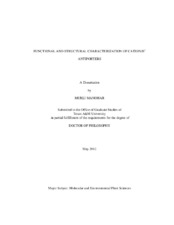| dc.description.abstract | Inorganic cations play decisive roles in many cellular and physiological processes and are essential components of plant nutrition. Therefore, the uptake of cations and their redistribution must be precisely controlled. Vacuolar antiporters are important elements in mediating the intracellular sequestration of these cations. CAXs (for CAtion eXchanger) are members of a multigene family and appear to predominately reside on vacuoles. Defining CAX regulation and substrate specificity have been aided by utilizing yeast as an experimental tool. Studies in plants suggest CAXs regulate apoplastic Ca2+ levels in order to optimize cell wall expansion, photosynthesis, transpiration and plant productivity. CAX studies provide the basis for making designer transporters that have been used to develop nutrient enhanced crops and plants for remediating toxic soils.
In my second study, I have characterized and defined autoinhibitory domain of Arabidopsis CAX3. Several CAX transporters, including CAX1, appear to contain an approximately 40 amino acid N-terminal regulatory regions (NRR) that modulates transport through N-terminal autoinhibition. Deletion of the NRR from several CAXs (sCAX) enhances function in plant and yeast expression assays; however, to date, there are no functional assays for CAX3. In this report, we create a series of truncations in the CAX3 NRR and demonstrate activation of CAX3 in both yeast and plants by truncating a large portion of the NRR. Experiments on endomembrane-enriched vesicles isolated from yeast expressing activated CAX3 demonstrate that the gene encodes Ca2+/H+ exchange with properties distinct from CAX1. These studies demonstrate shared and unique aspects of CAX1 and CAX3 transport and regulation.
My third study is to express and purify CAX proteins for X-ray crystallographic analysis. In this study, I initiated crystallization of vacuolar membrane localized CAX protein from eukaryotes. Membrane proteins continue to be challenging targets for structural biology because of their hydrophobic nature. We have demonstrated here that eukaryotic Ca2+/H+ exchanger can be successfully expressed in E. coli based expression system. Collectively, our findings suggest that CAX protein can be successfully expressed, detergent solublized and purified from E. coli with a yield sufficient for functional and structural studies. | en |


